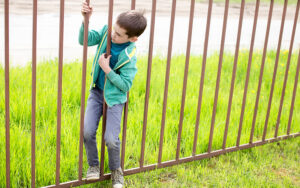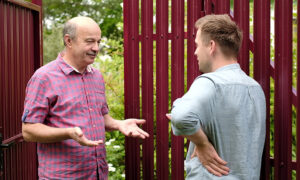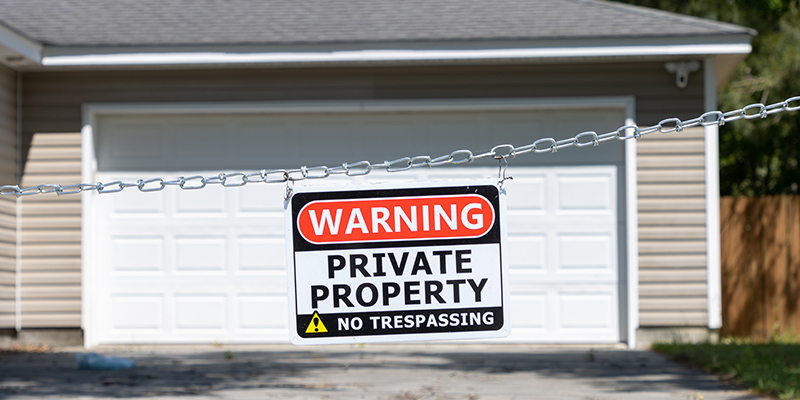It’s not uncommon to find issues involving encroachment in HOA communities. The homeowners or even the HOA may encroach on another homeowner’s property. When this happens, it’s important for HOAs to know how to handle the situation.
What Is Encroachment in HOA Communities?
Encroachment in HOA communities happens when someone goes onto another person’s property without consent. This can happen when a person steps foot on someone else’s property without permission. However, in HOAs, it often happens when a homeowner’s home or belongings cross the boundary lines onto a neighbor’s property.
Usually, encroachment of land by neighbor happens when a homeowner’s fence, garden, patio, roof overhang, or landscaping crosses property boundaries. It often also occurs when vegetation from one property begins to grow on or cross into another property.
One of the most common HOA encroachment issues involves encroaching trees. That’s because trees can fall onto a neighbor’s property when they become unsteady. A homeowner’s tree branches may also hang over property that is not theirs. These become especially problematic when they interfere with the neighbor’s use of property.
Easements: Acceptable Encroachments
There are times when minor encroachments are permitted in HOA communities. When a homeowner or the HOA has the legal right to cross property lines or make limited use of someone else’s property, it’s called an easement.
The community’s Declaration of Covenants, Conditions, and Restrictions (CC&Rs) often contain an HOA encroachment policy to address these easements. For example, a property owner’s overhanging roof may be allowed to encroach on neighbor or association property if the homeowner’s wall sits on the property line.
Other common examples of permissible encroachment include allowance for community members to plant gardens in the HOA’s common areas. If the governing documents allow this, homeowners cannot be penalized for the act.
HOA Common Area Encroachment
 Encroachment issues happen not just between homeowners. At times, some homeowners may even encroach onto common areas. While there may be easements for these types of encroachments, this is not always the case.
Encroachment issues happen not just between homeowners. At times, some homeowners may even encroach onto common areas. While there may be easements for these types of encroachments, this is not always the case.
Moreover, how much common area encroachment is acceptable will vary from HOA to HOA. They may also differ when it comes to obtaining permission.
For example, some communities may allow homeowners to plant gardens in common areas as long as they obtain permission. They can submit a request to the HOA board to do so. The board may allow the action under certain conditions. Meanwhile, other communities are stricter and do not allow this, even if the homeowner asks for permission from the HOA board.
How to Handle Property Encroachment
Homeowners associations may be at a loss when these issues arise. The board members and homeowners may not always know what to do about encroachment. How do you resolve an encroachment issue in your community? Here are some basic guidelines to follow.
1. Review the Property Boundaries
The first step to resolving encroachments is to review the property boundaries. Those on the receiving end of the encroachment should do this to verify whether or not the encroachment exists. Otherwise, they may be wasting time engaging in a conflict with their neighbor, who indeed had the right to use said property.
Apart from those affected by the encroachment, HOAs should encourage everyone in the community to review their property boundaries. The board should also remind them of the HOA’s rules and regulations regarding encroachments. To avoid any mishaps, the board can tell the homeowners to put everything in writing before starting any home improvement projects.
2. Never Take Matters Into Your Own Hands
Homeowners who face encroachment should never take matters into their own hands. For example, a neighbor’s tree may be encroaching on your property. In these cases, it’s best not to cut off the tree’s branches or limbs without first talking to the neighbor.
This can result in legal liability. The person who cut off the tree’s limbs may need to pay damages and even attorney’s fees. In fact, certain states even have laws that address this specific issue. For example, the Code of Alabama imposes fines on those who cut certain trees on property not their own.
3. Engage in Informal Discussion
 When it comes to resolving encroachment in HOA communities, the best place to start is by engaging in informal discussions. The affected party should approach the encroacher. They may simply be unaware of the encroachment and can quickly resolve the issue.
When it comes to resolving encroachment in HOA communities, the best place to start is by engaging in informal discussions. The affected party should approach the encroacher. They may simply be unaware of the encroachment and can quickly resolve the issue.
In many cases, simply talking to the other party settles the problem. The parties can often come to an agreement themselves without involving anyone else. For example, the person affected may choose to provide written permission or even sell part of the property to the other party. Regardless of the resolution, informal discussions help both parties avoid unnecessary conflict or a lengthy and expensive legal battle.
4. Use the HOA’s Dispute Resolution Mechanisms
If the matter cannot be resolved between the two homeowners, they can use the HOA’s dispute resolution mechanisms. Many homeowners associations outline a dispute resolution process in their governing documents. These often involve letting the homeowners submit a written complaint to the HOA board. The board will then review the issue at hand and help the neighbors resolve the issue.
If internal dispute resolution does not work, the HOA board may also use mediation or arbitration. This allows the homeowners to resolve the dispute without going to court. These methods allow a neutral third party to act as an intermediary between the affected parties.
5. Legal Action
As a last resort, homeowners may take legal action to resolve the encroachment issue. The court can decide for the parties and force compliance. However, this process can be lengthy and costly for the parties involved.
Common Encroachment Resolutions
When the board intervenes in encroachment issues, they often resolve the problem in a few different ways. The most common resolution they use is to ask the homeowner to remove the encroachment. They may issue a violation notice and ask the homeowner to comply.
After giving notice and holding a hearing, the offending homeowner may also face HOA fines. Some homeowners associations also remove the encroachment themselves and send the bill to the offending homeowner.
A Fine Line
There is a fine line between property boundaries in homeowners associations. Not all homeowners are aware of these boundary lines, and even when they are, they may still intentionally try to encroach on other people’s property. Regardless of whether the act was intentional, the board should always address encroachment in HOA communities reasonably.
Managing violations related to encroachment can be hard for homeowners associations. With HOA management software like Condo Manager, handling these issues becomes much less of a problem. Call us today at (800) 626-1267 or contact us online to find out more!
RELATED ARTICLES:



